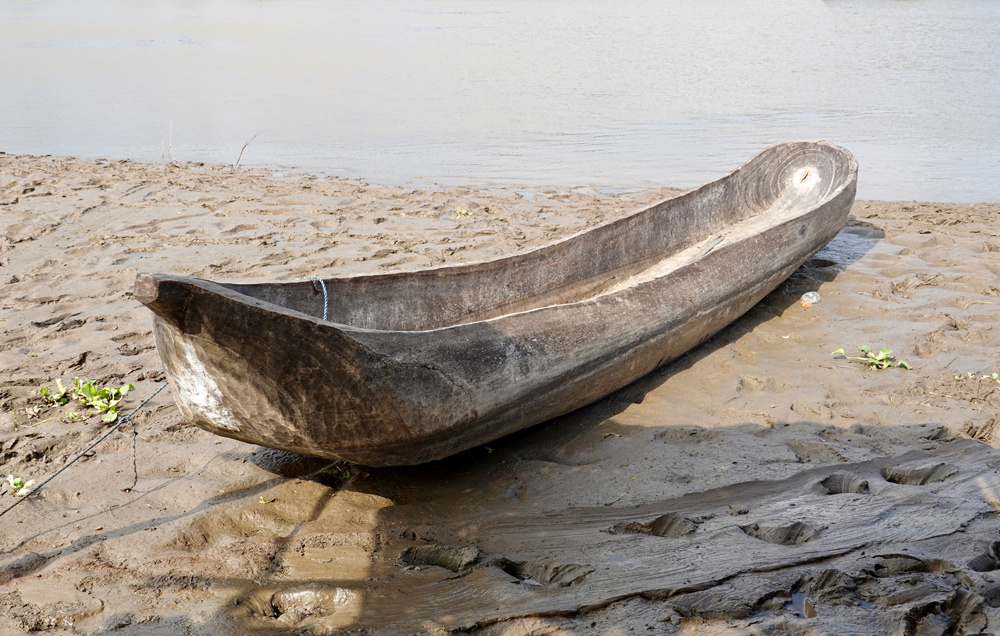In Pittsburgh, Meriwether Lewis is building the barge prior to departing down the Ohio River. Here, two Ohio River boats of the day—barges and pirogues—are compared in the context of navigating from Pittsburgh to New Orleans.
Pirogue
Mono River, Benin
By Wiki Commons user Kulttuurinavigaattori. Permission by the Creative Commons Attribution-Share Alike 4.0 International license.
Navigating Pittsburgh to New Orleans
The navigation of the Ohio and Mississippi is so much improved of late that they can tell almost to a certainty the distance from Pittsburgh to New Orleans, which they compute to be two thousand one hundred miles. The barges in the spring season usually take forty or fifty days to make the passage, which two or three persons in a pirogue make in five and-twenty days.
—François André Michaux[1]Travels to the West of the Alleghany Mountains (1805 reprint from London edition), p. 62–3 in Reuben G. Thwaites, Travels West of the Alleghanies (Cleveland: The Arthur H. Clark Co., 1904), p. … Continue reading
Barges and Pirogues
Timothy Flint, after his own trip down the Ohio River in 1815, describes four types of boats used on that river. Here, the barge and pirogue are presented:
Many travellers and emigrants to this region, view the first samples of the modes of travelling in the western world, on the Allegany at Oleanne point [Olean, New York], or the Monongahela at Brownsville. These are but the retail specimens. At Pittsburg, where these rivers meet, you have the thing in gross, and by wholesale. The first thing that strikes a stranger from the Atlantic, arrived at the boat-landing, is the singular, whimsical, and amusing spectacle, of the varieties of water-craft, of all shape and structures. There is the the [sic] stately barge, of the size of a large Atlantic schooner, with its raised and outlandish looking deck. This kind of craft, however, which required twenty-five hands to work it up stream, is almost gone into disuse, and though so common ten years ago, is now scarcely seen.
. . . . .
In another place are pirogues of from two to four tons burthen, hollowed sometimes from one prodigious tree, or from the trunks of two trees united, and a plank-rim fitted to the upper part. There are common skiffs, and other small craft, named, from the manner of making them, “dug-outs,” and canoes hollowed from smaller trees.[2]Timothy Flint, Recollections of the Last Ten Years, Passed in Occasional Residences and Journeyings in the Valley the Mississippi, from Pittsburg and the Missouri to the Gulf of Mexico, from Florida … Continue reading
Experience the Lewis and Clark Trail
The Lewis and Clark Trail Experience—our sister site at lewisandclark.travel—connects the world to people and places on the Lewis and Clark Trail.
Plan a trip related to August 6, 1803:

Notes
| ↑1 | Travels to the West of the Alleghany Mountains (1805 reprint from London edition), p. 62–3 in Reuben G. Thwaites, Travels West of the Alleghanies (Cleveland: The Arthur H. Clark Co., 1904), p. 159–60. |
|---|---|
| ↑2 | Timothy Flint, Recollections of the Last Ten Years, Passed in Occasional Residences and Journeyings in the Valley the Mississippi, from Pittsburg and the Missouri to the Gulf of Mexico, from Florida to the Spanish Frontier. . . (Boston: Cummings, Hilliard, and Company, 1826), 13–4. |

